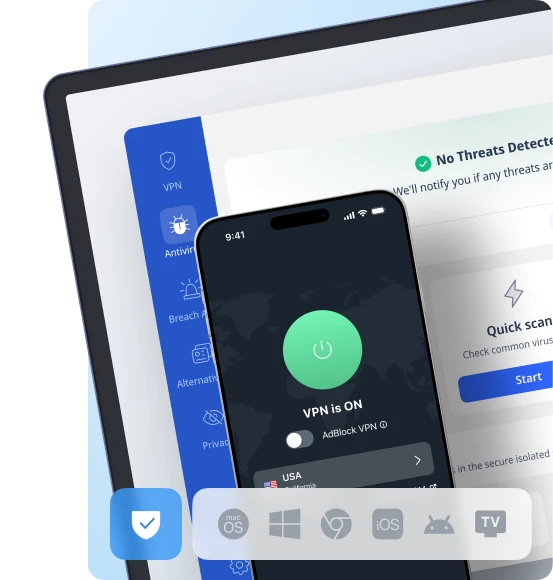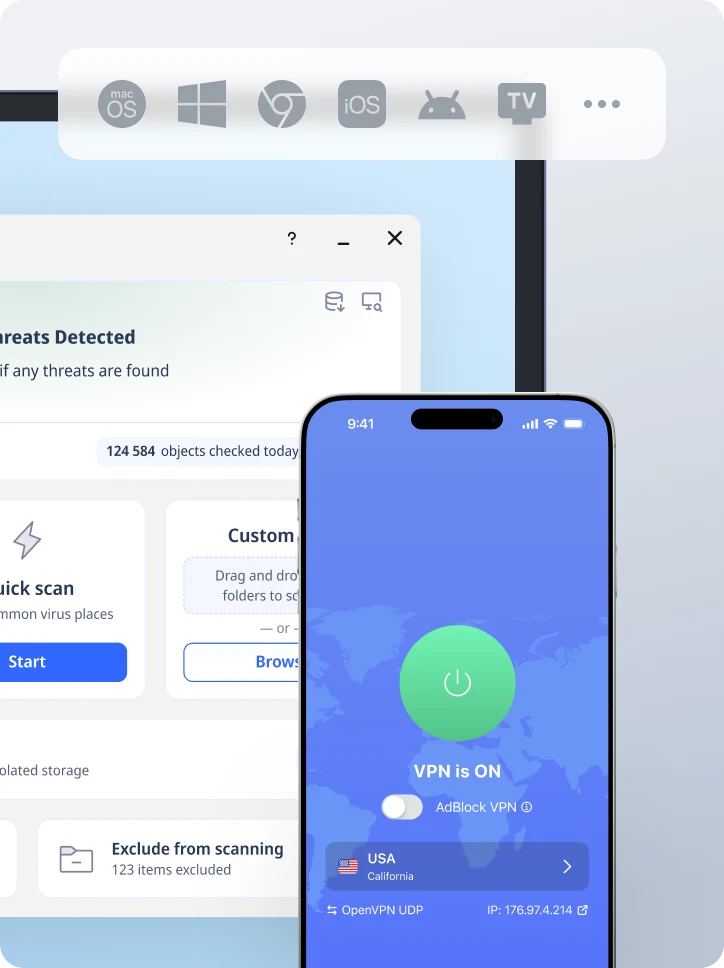How to Secure Your Mac Online: Essential Tips and Tools for 2025
Mac users think their devices are cyber threat proof because of Apple’s reputation for being secure. But here’s the truth: no system is invincible. This guide will help you improve your Mac’s security by using built-in features and best practices to protect against cyber threats. While macOS has impressive built-in protections, it’s important to note that modern Macs have automatic update features enabled by default to apply security patches and software updates but users should still be proactive. Real world threats like phishing, unsecured public Wi-Fi, data tracking and spyware still pose serious risks. If you’re not proactive, your sleek MacBook will become a backdoor for hackers.
That’s where VeePN comes in. Whether you’re working remotely, shopping online or streaming your favorite series, VeePN adds an impenetrable layer of protection between you and digital dangers. With strong encryption, a global network of servers and zero-log privacy, VeePN makes your Mac experience as secure as it is smooth.

Why Mac security still matters
It’s a myth that Mac computers don’t get viruses or malware. Although less targeted than Windows machines, Macs face rising threats, especially as their market share grows. Compared to Windows PCs, Macs are generally less vulnerable to certain types of malware but they are not immune and still need robust protection. In 2023 alone, Mac specific malware attacks increased by over 50%. Common threats include:
- Phishing attempts via email or fake pop-ups
- Spyware and stalkerware bundled with third-party downloads
- Data interception on public WiFi
- Browser fingerprinting and third-party tracking
- Outdated or unused software which can create a security risk by exposing vulnerabilities
Use a VPN (virtual private network)
A VPN is no longer optional, it’s a digital shield for your data. Especially when you’re on public networks at cafes, airports or hotels, your personal information can be intercepted.
VeePN is designed for Mac users who value both performance and privacy. Here’s what it offers:
🛡️AES-256 encryption to keep your traffic private
🛡️No Logs policy to keep your data yours
🛡️Over 2,500 servers in 89 locations to bypass geo-blocks
🛡️One account for up to 10 devices
Enable FileVault encryptionFileVault
Apple’s FileVault encrypts your hard drive so your data is inaccessible without your password even if your Mac is stolen. To enable it:
- Go to System Settings > Privacy & Security, then select the FileVault tab
- Click security options as needed, then click Turn On FileVault
- Set a recovery key
Keep your software updated
Outdated software is a hacker’s playground. Apple releases updates that patch critical vulnerabilities regularly.
- Turn on automatic updates via System Settings > General > Software Update > Automatic Updates. Make sure automatic updates are enabled and working correctly to get security patches and software updates.
- In the Software Update section, click the Advanced button to access more update options. Check all the boxes to enable all available update types for maximum security and performance.
- Ensure updates are downloaded and installed properly to keep your system secure and stable.
- Update browsers and apps regularly
Use a strong password and 2FA
Always use a more complex password and make sure you have unique complicated passwords for each account. A complex password, especially when combined with biometrics like Touch ID, is great security. A password is essential and can be managed efficiently with password managers which generate and store unique, secure passwords across your devices. Remember, your computer’s password is still required as a backup login method especially after restarting your device.
Enable two-factor authentication (2FA) on your Apple ID for extra security:
- Go to System Settings > Your Apple ID > Password & Security
- Toggle on Two-Factor Authentication
Turn on the Mac firewall
macOS has a built-in firewall that blocks incoming traffic. To turn it on, go to System Preferences (or System Settings) > Network > Firewall tab > Turn On Firewall
Lock down Safari and browsers
Configure your browser to minimize tracking and boost privacy:
- Use Safari’s Intelligent Tracking Prevention
- Block pop-ups and auto-play media
- Use privacy extensions like HTTPS Everywhere
- Clear cookies regularly
Disable unused services
Minimize attack surfaces by disabling:
- Bluetooth (if not used)
- AirDrop (set to “Contacts Only” or off)
- Remote Login and Management features
Monitor app permissions
Rreview which applications have access to your information:
- Privacy tab in System Settings.
- To manage the permissions of the apps, go to the Privacy tab in System Settings. This is where you can restrict the access of sensitive information such as your location, contacts and calendar to the apps.
Avoid granting apps permission by limiting their access and frequently reviewing their permission to enhance your security and privacy. You should also confirm the settings of location services and ensure that only trusted apps have access to the location of your device, which you need to use such functions as tracking and privacy protection.
Use a standard user account
Don’t use an admin account daily. Use a standard user account for daily tasks and reserve administrator privileges for software updates. Limit the number of administrative users on your device to enhance security and reduce the risk of unauthorized changes. When managing other users on a shared device, assign them standard accounts and don’t give them administrator privileges. For temporary access consider enabling a guest user account which allows limited access without compromising your main data or settings.
Secure Your Mac’s Screen
Screen locking your Mac is an easy, but a strong protection of very personal information, which should not be viewed by others. Begin by installing a screen saver which has a password lock. Go to System Settings > Security & Privacy > General and make sure there is a check mark in the box that requires the use of a password as soon as the screen saver starts or the screen goes to sleep. To lock even quicker just set up a hot corner- simply go to System Settings > Desktop & Screen Saver > Hot Corners and choose a corner to lock the screen. To add an additional security measure, enable the option in order to enter a password to unlock each System Preferences pane. Check your screen lock preferences every now and then so that you can have your Mac screen locked even when you take a little moment off.
iCloud and App Store security
Your iCloud and the App Store are the key to your Apple devices and personal information thus it is important to keep it safe. You should have a powerful and distinct password to your Apple ID and have two factor authentication to avoid unauthorized access. Review your iCloud account settings regularly by checking whether your log in details are current and safe.
When downloading new apps that you find on the App Store, make sure you use the developers you trust, and be careful of the accesses you give the apps and particularly the ones that ask you to provide information about your location, contacts or any other sensitive data. Visit System Settings > Privacy & Security periodically to ensure that you only allow the minimum number of apps to use your data. In this way, being vigilant will ensure the safety of your Mac and your very personal data against the unnecessary risks.
Lockdown and physical security
To stay as safe as possible Apple provides Lockdown Mode such an option that protects against the most highly targeted attacks. On System Settings > Privacy & Security, enable Lockdown Mode so that specific apps and capabilities are disabled to reduce the number of vulnerabilities. Physical security is equally essential: a Kensington lock or the like should be used to secure against theft and Find My Mac should always be switched on to enable you to track down a lost or stolen Mac.
Another good idea is to create a guest account so that other people could use your Mac, but without gaining access to your files and applications. To add an additional layer of security you can add a physical security key or token to your login. These measures will make your Mac safe on the web and without it.
Phishing protection
Mac users are also at the risk of phishing. Watch what you do with emails, messages and websites that request your log in or financial details. Always recheck the sender information and do not open any suspicious links as well as download unpredictable attachments. Verify your Apple account by using two factor authentication and password manager to generate and save unique and complex passwords to each account. Check your Security and Privacy in System Settings to ensure that your Mac is safe against the most recent threats. Be watchful and active to ensure your personal information does not fall to phishing.
Review your security settings
The security of your Mac is a process. You should get in the habit of reviewing your settings in System Preferences > Security & Privacy. Don’t forget to change your login password frequently and also think of enabling FileVault to secure your most personal information. Add an alternate sign-in method such as Touch ID to be more convenient and secure.
Go to your app permissions and privacy permissions and ensure that you only give access to your data to trusted apps. Keep your programs updated and think of using a VPN to secure your privacy on the Internet. Checking your security settings will make your Mac a secure place to carry out all your online tasks.
VeePN for complete online protection
Apple has tools but only VeePN has full digital defense:
- Secures public WiFi connections
- Bypasses geoblocks
- Prevents Internet Service Provider (ISP) throttling
- Conceals your identity
How to set up VeePN on your Mac
- Download VeePN from veepn.com
- Create an account and choose a plan
- Open the app and connect to a server
- Turn on Kill Switch and Auto-connect
Conclusion
Your Mac is strong but not invincible. You can’t lock it down completely but by following these steps you’ll secure it a lot. If you have an older Mac pay extra attention to your security settings as some features might not be enabled by default. Fortify its defenses by combining Apple’s security with VeePN’s protection.
VeePN is freedom
Download VeePN Client for All Platforms
Enjoy a smooth VPN experience anywhere, anytime. No matter the device you have — phone or laptop, tablet or router — VeePN’s next-gen data protection and ultra-fast speeds will cover all of them.
Download for PC Download for Mac IOS and Android App
IOS and Android App
Want secure browsing while reading this?
See the difference for yourself - Try VeePN PRO for 3-days for $1, no risk, no pressure.
Start My $1 TrialThen VeePN PRO 1-year plan








